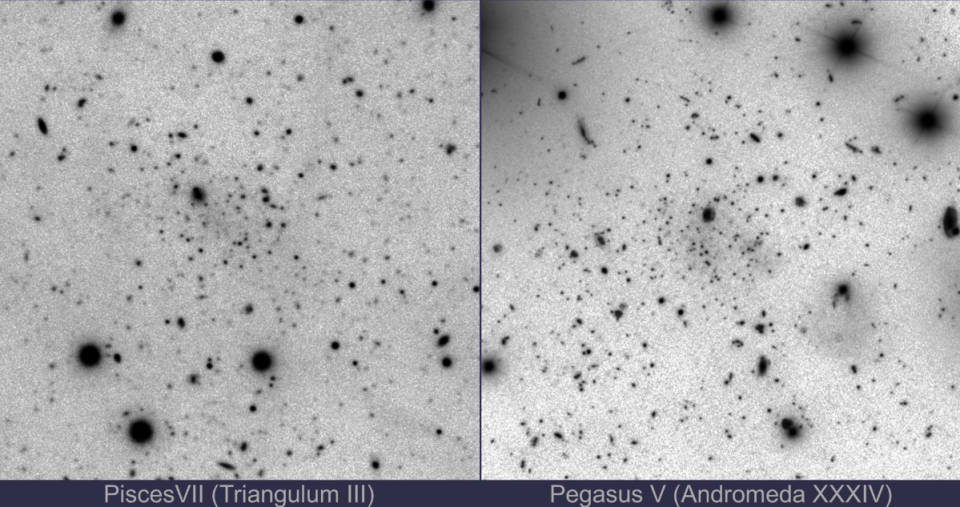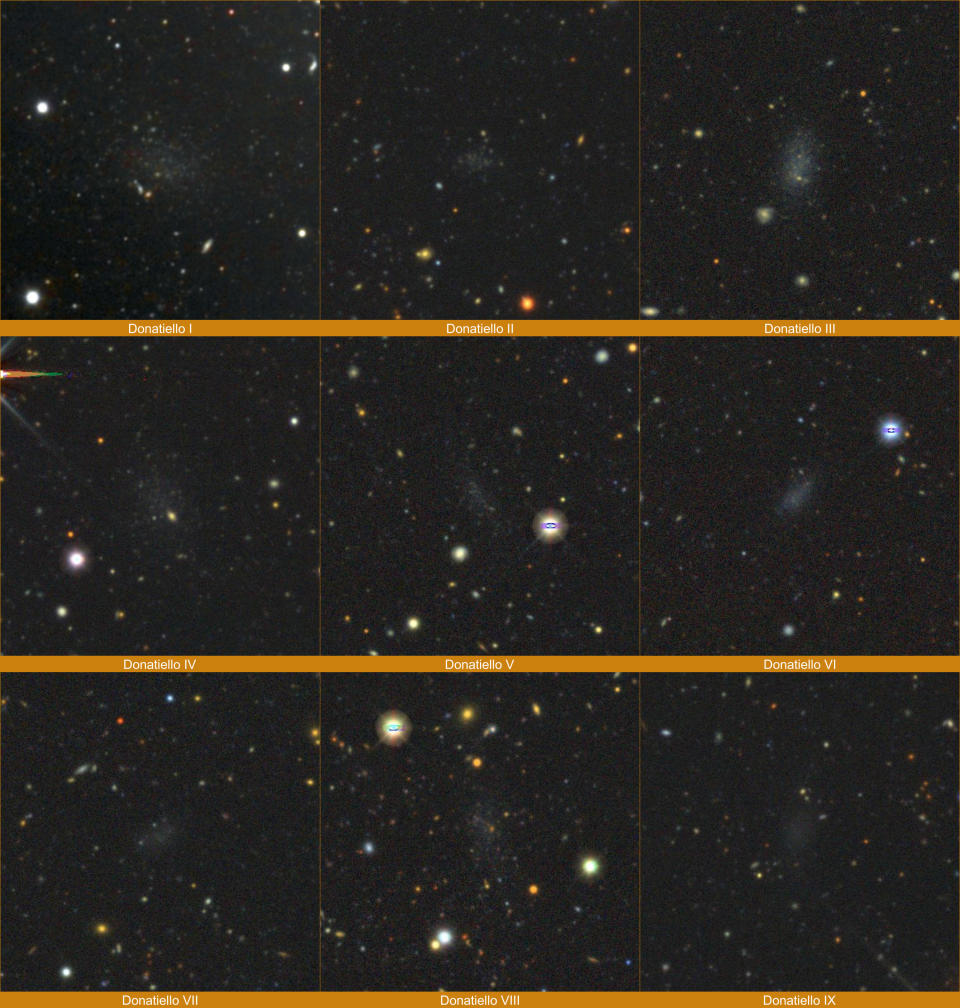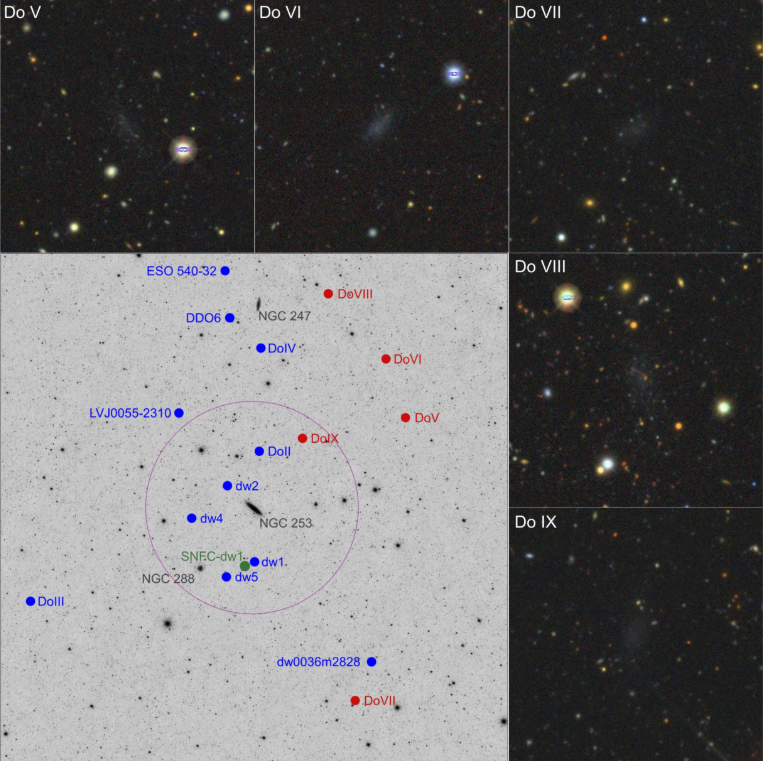An amateur astronomer from Italy has discovered five new dwarf galaxies surrounding a distant spiral galaxy – a spiral that is one of the largest galaxies in the sky above Earth. His name is Giuseppe Donatiello, and those five dwarf galaxies are now called Donatiello V, Donatiello VI, Donatiello VII, Donatiello VIII and Donatiello IX (Do V, Do VI, Do VII, Do VIII and Do IX).
“Of the 11 discoveries, nine galaxies bear my name. To my knowledge, I am the first and only amateur astronomer to have galaxies named after them,” Donatiello told Space.com. “It all started with the first discovery in 2016, when I found in my astrophotographs what we would call Donatiello I. Although this was an unusual practice, the new galaxy got my name, and it was a great joy.”
The newly discovered satellite galaxies join the three previous dwarf galaxies that Donatiello discovered around the Sculptor galaxy, officially known as NGC 253 – and are in many ways interesting for reasons other than their nomenclature.
Not only are ultra-faint small galaxies like this one, which averages 11.5 million light-years away from Earth, difficult to detect, but these galaxies could help astronomers study the oldest stars in our universe, determine the nature and distribution of dark matter parse, and perhaps even influence current models of cosmology.
Related: The world’s largest visible light telescope spies a cluster of galaxies that is warping spacetime
“In general, dwarf galaxies are objects of very low luminosity. Suffice to say, many satellites of the Milky Way are difficult to detect because they are well camouflaged in the star fields,” Donatiello said. ‘For external galaxies this is becoming increasingly difficult. After just a few megaparsecs [one megaparsec is equal to around 3.3 million light-years]the faintest dwarf galaxies have faded into the background of the sky.
“Every new discovery is therefore important, both in terms of counts and for better knowledge of these systems and their evolution.”
Where are all the dwarf galaxies?
As Donatiello explains, the Milky Way has its own satellite dwarf galaxies. However, in 1999 astronomers knew of only about a dozen dwarf galaxies around our Milky Way – but thanks to discoveries made since 2004, we are currently aware of about 60 satellite galaxies around our realm. This is interesting because it can tell us something about the dynamics of dark matter.
“We know that large galaxies must be at the center of dark matter halos, which extend far beyond the size of the stellar disk,” says Donatiello. ‘According to cosmologists, these halos formed first and acted as a gravitational source for the neutral gas at the origin of the very first stars, creating the first galaxies.
‘Some of these haloes have become gravitationally dominant and act as an attractor for other nearby halos. This process triggered the hierarchical formation of large galaxies. Furthermore, each halo contains a number of mini-halos that in turn formed the cosmic galaxies. scaffolding for satellite systems.”
However, there is a bit of a mystery when it comes to satellite galaxies. It has to do with a much-loved cosmological model known as the Lamba Cold Dark Matter (LCDM) model, which suggests that there really should be thousands of satellite galaxies surrounding the Milky Way and other large galaxies. In fact, simulations made using LCDM predict that our neighboring galaxy, Andromeda, should be surrounded by 500 to 1,000 satellite galaxies. Yet astronomers have only seen 39 around Andromeda – including Pisces VII and Pegasus V, which were discovered by Donatiello himself.

“This discrepancy has become known as the ‘missing satellite problem’. After 25 years, no convincing solution has emerged because, even with the discovery of ultra-faint galaxies, the number remains remarkably low,” Donatiello explains. “There are still increasingly fewer dwarf galaxies than expected, so the problem remains: where are they all?”
This dilemma has led scientists to wonder whether the LCDM model can indeed predict that dark matter acts as a platform for the formation of the largest structures in the universe, but collapses when it probes the cosmos on smaller scales. Why would it fail to detect sufficient numbers of dwarf galaxies around large galaxies?
As for why this all matters, the study of dwarf galaxies is critical to our understanding of galactic evolution, because it could also help us better understand the creepy cannibalistic processes that larger galaxies like the Milky Way and Andromeda have used to to grow.
“One of NGC 253’s satellites, Scl-MM-dw2, has already been observed to undergo tidal destruction while being absorbed by the Sculptor galaxy,” Donatiello said, explaining that the galaxy shows clear signs of recent interaction. as well as hints of stellar flows, which refer to stars being dragged out of a dwarf galaxy by gravitational interactions with a larger galaxy.


To investigate whether LCDM models may need to be revised or efforts increased to hunt dwarf galaxies around larger galaxies, Donatiello and his team turned to archival data collected by the Dark Energy Spectroscopic Instrument (DESI) on the 4-meter Mayall telescope in Kitt. National Observatory Peak.
In 2021, the instrument began a five-year survey of 35 million galaxies and quasars, but Donatiello and colleagues focused specifically on their observations of the Sculptor galaxy and its surroundings. “NGC 253, thanks to its proximity, is an optimal laboratory for investigating these structures, their interaction and evolution,” Donatiello said. “We can study the halo of this nearby galaxy by getting a general view of it, which cannot be done for the Milky Way.”
This study led to the discovery of eight dwarf galaxies in the Sculptor galactic group: the team revealed three in 2021, and the other five more recently. Astronomers now know of 18 galaxies in this grouping around NGC 253, including NGC 247, discovered in 2011, and some higher-mass dwarf galaxies.
Still, the team’s new discoveries are notable for their weakness.
“All other satellite galaxies in this group are spherical dwarfs that resemble the ‘classical’ satellite galaxies of the Milky Way, in the high-luminosity region,” Donatiello said. “Thanks to NGC 253’s satellite galaxy count, we now have a way to compare how fainter systems gradually disappear with increasing distance.”
Crooked and disorganized
The team’s count of the Sculptor galaxy and its surroundings may have revealed more dwarf satellite galaxies, bringing the image of this region closer to that predicted by LCDM, but it also yielded some surprises. This includes the fact that the distribution of dwarf galaxies around NGC 253 appears to be ‘skewed’, with more galaxies lying on one side of the Sculptor galaxy than on the other.
Donatiello noted that the reason for this skew could be related to the fact that the Sculptor Group satellite galaxies are part of a galactic “filament” that is almost perfectly aligned with the Virgo Cluster, a large cluster of galaxies whose center is is located about 54 million light years away. away.
“What we think of as satellite galaxies are actually falling objects attracted to the larger galaxy,” he explained. “In all cases of structures in the same plane or with unbalanced distributions, we find a close relationship with this cosmic filament. So we can assume that the specific skewed structure is driven by this scenario. Otherwise, we should expect a more even distribution.” .”


“Even more extreme objects have recently been found, consisting of several dozen stars, which we find difficult to define as galaxies, but rather as halo clusters,” Donatiello said. “There are probably hundreds of such star systems waiting to be discovered. There is still room for more discoveries. However, the DESI data may not be deep enough to find new low-luminosity candidates.”
The amateur astronomer added that new, more powerful research instruments such as the Vera C. Rubin Telescope could pick up this research by detecting systems so faint that at a certain distance they become effectively invisible to current technology.
“What if we don’t find enough ultra-faint dwarf galaxies to weaken the missing satellite problem?” Donatiello asked rhetorically. ‘We have to take into account that the models will need to be revised or some mechanism will take over that inhibits star formation below a certain mass limit of dark matter halos.
“It could also be that there is something wrong with the timing of the formation of the larger galaxies, and most dwarf galaxies have almost all been swallowed up by the larger ones.”
Related stories:
– Stephan’s Quintet: ‘It’s a Wonderful Life’ – and a beautiful image of the James Webb Space Telescope!
— Scientists find a supercluster of galaxies with a mass of 26 quadrillion suns
— The James Webb Space Telescope may have found some of the very first stars
Currently, nine galaxies, including the eight dwarf satellites of the Sculptor Galaxy, bear Donatiello’s name – but for him, this research is more about the thrill of new discoveries than the honor of having his name integrated into astronomy textbooks.
“How does it feel to have galaxies named after me?” he concluded. “It’s a nice feeling, but I’ve also gotten a bit used to it!”
The team’s findings are available as a pre-peer-reviewed article on the research repository arXiv.